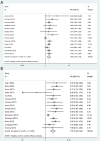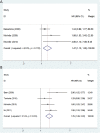Prognostic Role of C-Reactive Protein In Urological Cancers: A Meta-Analysis
- PMID: 26235332
- PMCID: PMC4522672
- DOI: 10.1038/srep12733
Prognostic Role of C-Reactive Protein In Urological Cancers: A Meta-Analysis
Abstract
Growing evidence suggests serum C-reactive protein (CRP) can serve as a prognostic marker in urological cancers. However, some studies yield contradictory results. Our objective was to determine the relationship between baseline serum CRP and survival outcome in urological cancers. We searched PubMed and EMBASE databases until October 2014 without language restrictions. 44 independent studies investigating the association between baseline serum CRP and cancer-specific survival (CSS) or overall survival (OS) were selected. High CRP yielded a worse survival in renal cell carcinoma, prostate cancer, bladder cancer, and upper urinary tract urothelial carcinoma. Combined results of meta-analyses indicated that CRP was a prognostic factor in urological cancers (CSS: p < 0.01; OS: p < 0.01). Subgroup analyses confirmed the significant association between CRP and prognosis, regardless of race and cutoff value of CRP. Specifically, prognostic impact of CRP was also noted in patients with localized RCC treated with nephrectomy (CSS: p < 0.01) and metastatic RCC treated with molecular-targeted therapy (OS: p < 0.01). In conclusion, serum CRP is an independent prognostic factor in urological cancers and risk stratification by serum CRP level could be helpful for prognostic assessment.
Figures





References
-
- Ferlay J. et al. Estimates of worldwide burden of cancer in 2008: GLOBOCAN 2008. International journal of cancer. Int J Cancer 127, 2893–2917 (2010). - PubMed
-
- Soerjomataram I. et al. Global burden of cancer in 2008: a systematic analysis of disability-adjusted life-years in 12 world regions. Lancet 380, 1840–1850 (2012). - PubMed
-
- Bex A. et al. Integrating Surgery with Targeted Therapies for Renal Cell Carcinoma: Current Evidence and Ongoing Trials. Eur Urol 58, 819–828 (2010). - PubMed
-
- Cancer Research UK. Cancer Statistics Report: Cancer Incidence and Mortality in the UK. (2014) Available at: www.cancerresearchuk.org. (Accessed: 4th October 2014)
-
- Eisenberg M. S. et al. The SPARC score: a multifactorial outcome prediction model for patients undergoing radical cystectomy for bladder cancer. J Urol 190, 2005–2010 (2013). - PubMed
Publication types
MeSH terms
Substances
LinkOut - more resources
Full Text Sources
Other Literature Sources
Research Materials
Miscellaneous

